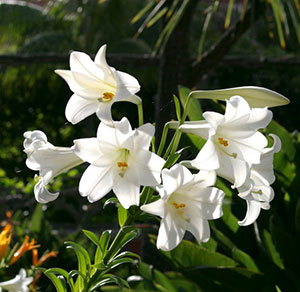Easter Lily

The white, trumpet-shaped flowers of the Easter lily symbolize the new life of spring.
When purchasing an Easter lily, choose a plant that looks attractive from all angles. The rich, green leaves should be dense and plentiful for the entire height of the plant. Look for a lily with one or two open or partly open flowers and three or more unopened buds.
In your home, place the lily near a window that receives bright, indirect natural light, and out of direct sunlight. To prolong the life of each flower, remove the yellow anthers before they begin to shed pollen.
Native to Japan, and commercially grown here in the Pacific Northwest, the Easter lily (Lilium longiflorum) can nonetheless be planted in Florida gardens. When the last danger of frost has passed, plant your Easter lily in a well-drained, sunny location. Continue to water thoroughly as needed, and consider using a slow-release fertilizer every six weeks.
As the original plants begin to die back, cut the stems back to the soil surface. While commercials nurseries force the plants to bloom under controlled greenhouse conditions in March, your Easter lily will probably bloom naturally in the summer. Mulching helps conserve moisture in between waterings.
As the plants fades, be sure to provide winter protection for the underground bulbs by mulching the ground with a thick, generous layer of straw, pine needles, or leaves. Carefully remove the mulch in the spring to allow new shoots to come up. Easter lily, like many other types of garden lilies grown in Florida, contains various toxic alkaloids and can cause poisoning if consumed.
